Учебное пособие Издательство Томского политехнического университета 2009
| Вид материала | Учебное пособие |
- Редакционно-издательским советом Томского политехнического университета Издательство, 1434.78kb.
- Редакционно-издательским советом Томского политехнического университета Издательство, 3189.24kb.
- Редакционно-издательским советом Томского политехнического университета Издательство, 2424.52kb.
- Редакционно-издательским советом Томского политехнического университета Издательство, 2585.19kb.
- Редакционно-издательским советом Томского политехнического университета Издательство, 1488.99kb.
- Учебное пособие подготовлено на кафедре философии Томского политехнического университета, 1526.78kb.
- Учебное пособие Издательство Томского политехнического университета Томск 2007, 1320kb.
- Учебное пособие Рекомендовано в качестве учебного пособия Редакционно-издательским, 2331.42kb.
- М. В. Иванова Томск: Издательство Томского политехнического университета, 2008. 177, 2610.26kb.
- Я управления рисками в организации рекомендовано в качестве учебного пособия Редакционно-издательским, 1160.94kb.
Vasily Ivanovich Surikov was born in Krasnoyarsk into a family of Siberian Cossacks, whose ancestors came to conquer Siberia with Yermak in the 16th century (“The Conquest of Siberia by Yermak”). The future artist grew up among brave and solid people, in severe natural conditions. Surikov said later that Siberia gave him the ideals of historical characters, spirit, strength and health. After finishing school in 1868, the young man left for St. Petersburg on horse-back to join the Academy. He spent a year on his journey, because on his way he made frequent stops in the ancient towns through which he passed. In 1869, he entered the Academy of Art, where he studied excellently.
In 1875 Surikov moved to Moscow, where he settled permanently. Moscow with its old architecture impressed the artist deeply. The views of the Red Square, monasteries and cathedrals, Kitay-Gorod called to mind dramatic historical events. When he moved to Moscow, this center of the nation, he immediately found his way in art.' On impulse, he started the big historical canvas “Morning of Strelets' Execution”(finished in 1881). This painting defined the main direction of his work - depiction of Russians in turning points of their history.
The next big painting, “ Menshikov in Berezovo”, dealt with the personal drama of an outstanding politician. Once a mighty courtier, the right hand of Peter the Great, now an exile, Surikov's Menshikov impresses the viewers with his strong personality.
Menshikov, Peter's favorite, captained Russian forces in the field against the Turks and Swedes, executed the Streltsy, built the new capital of St. Petersburg on marshland, built ships, trained troops, organized commercial and industrial companies, engaged in diplomatic negotiations. Menshikov was a low-born Russian, whose talent and energy took him to the top during Peter's rule. Menshikov, with support of the guards, after Peter's death proclaimed the widowed Empress Catherine sovereign and ruled Russia in her name.
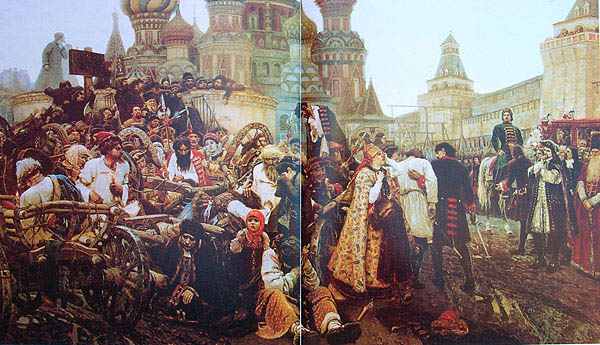
V.Surikov. The Morning of the Execution of the Streltsy. 1881. Oil on canvas.
218 x 379 cm. The Tretyakov Gallery, Moscow
After her death Peter II rebelled against Menshikov's authority. In 1727 Menshikov was placed under house arrest and dispatched to Beriozov, Siberia. Everything was confiscated. On his way there his wife died. Menshikov passed away in 1729 and his beautiful daughter Maria (previously engaged to Peter II) followed him one month later.
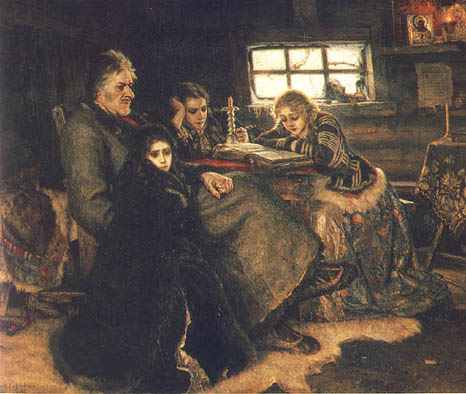
V. Surikov. Menshikov at Beriozov. 1883. Oil on canvas.
169 x 204 cm. The Tretyakov Gallery. Moscow
Surikov used gloomy colors to show Menshikov's thoughts and misfortunes that he brought down on his children. A diamond ring symbolized his previous brilliant career. The artist used his wife as a model depicting Menshikov's daughter Maria. Surikov painted glazings over impasto painting producing rich vibrant colors. Tretyakov paid 5000 rubles to acquire Menshikov for his gallery collection enabling the artist to travel abroad to Berlin, Dresden, Cologne, Paris, Milan, Florence, Rome, Naples, Venice, and Vienna with his family.
The interesting fact is that while getting foreign impressions, the artist thought out his next work from Russian history “ Boyarynya Morozova”. On his return Surikov started the work on the canvas.
The strife between tradition and reform developed itself in the XVIIth century. It was the collision between the Russian Orthodox Church and the reforms, which made the Church submitted to the tsar. In 1672 Morozova and her sister, Princess Urusova, were arrested and quietly kept in a pit in Borovsk, where Morozova died in 1675.
Morozova who represented Old Russian traditions was shown in the sledge by Surikov. The trong was divided into two groups. The right-hand group was her sympathizers, and in the left-hand group were Morozova's mocking enemies and indifferent people. Surikov spent over four years sketching to produce a realistic historical painting. Each figure, costume and face has its own meaning and expression. Surikov employed chiaroscuro, showing gorgeous color and three dimensional forms.
In 1887, Surikov's wife died. Her death caused a deep depression: he gave up painting, turned to religion, and left with his children for Siberia. The atmosphere, familiar from childhood, and the caring attitude of his friends restored him to life. In 1891, in Siberia, Surikov painted his most joyous picture “Taking of a Snow Fortress”, which shows a Siberian game in which a horseman must jump over a snow wall, defended by young people with twigs and whips. This cheerful painting is an exception in his art; all other paintings by Surikov are very serious.
After the “Taking of Snow Fortress” Surikov started painting “ The Conquest of Siberia by Yermak” (1895). The battle of the 16th century between the Cossacks under their ataman (commander) Yermak Timofeevich and the troops of Kuchum-Khan, the ruler of Siberia, he showed with reliability of a witness. Another big canvas, devoted to Cossacks is “Stepan Rasin”, which depicts the moment of the Cossacks return from a successful campaign against Persia.
Surikov executed only nine historical canvases out of hundreds of portraits, studies, and sketches, but he is still considered Russia's greatest historical painter.
Notes
- to think out – задумывать
- to ‘execute – выполнить, осуществить; казнить
- joyous - радостный
- a mighty courtier - могущественный придворный
- an exile - ссыльный, изгнанник
Task 11. True/false statements.
1. Surikov executed hundreds of historical paintings
2. The future artist grew up in Siberia
3. He spent twelve month on his journey from Novosibirsk to St. Petersburg.
4. His first historical canvas was “Menshikov in Berezovo”.
5. The collector of Russian art Pavel Tretyakov gave the artist money to go abroad.
6. Surikov’s most joyous picture is “Taking of a Snow Fortress”.
7. The painting “The Conquest of Siberia by Yermak” depicts a horseman, who must jump over a snow wall.
8. Vasily Ivanovich Surikov was born into a family of Siberian Cossacks, but he never depicted Cossacks in his art.
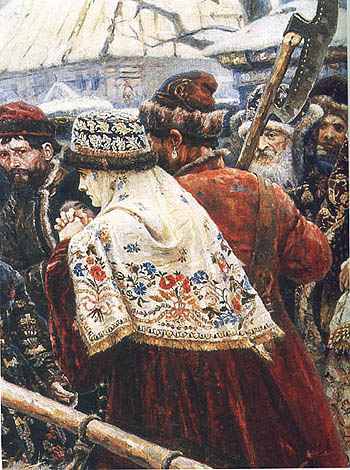 | 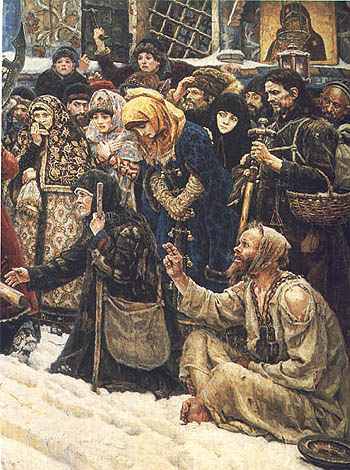 |
| V.Sirikov.The Boyarynia Morozova. Detail. | V.Surikov. The Boyarynia Morozova. Detail. |
Part 2
Besides historical pictures Surikov created many portraits and self-portraits which show the gift of the master and his interest into the inner world of his models. Surikov always focused on fine portraiture. His female images are particularly elaborate and masterful. He appreciated and knew how to depict the beauty of a Russian woman; he understood her contradictory personality, her tenderness, kindness, compassion, cordiality, quiet resignation, and readiness to sacrifice herself, and he recognized that sometimes, her courage, strong will, devil-may-care attitude, and her strong convictions bordered on fanaticism.
During that epoch - the heyday of portrait genre in Russian art - many artists tended to emphasize their characters' personalities in their historical and genre painting. Itinerants made a particularly notable contribution to portraiture. For the first time in Russian art, portraiture stopped being merely the art of painting family members and stopped serving exclusively the sentimental needs and vanity of individuals and families. As a result of the itinerants, the very word portrait acquires new understanding. The reason for the above we find in the definition of reconsidered art that achieved vivid social status. Art changed much. Now it served more for exhibition purposes rather than purely as private commissions.
Notes
contradictory personality – противоречивая личность
compassion - сострадание, сочувствие
quiet resignation - тихое смирение, покорность
cordiality - сердечность
to sacrifice oneself – жертвовать собой
strong will – сильная воля
devil-may-care attitude - наплевательское отношение
devil-may-care - беззаботный
strong convictions bordered on fanaticism – сильные убеждения, граничащие с фанатизмом
the heyday - - в расцветеб в зените
to emphasize their characters' personalities - акцентировать внимание на личностях героев
contribution - вклад
vanity of individuals – тщеславие людей
to acquire - приобретать
vivid - явный, яркий
private commissions – частные заказы
rather than - а не
Task 12. Describe the painting “Boyarina Morozova” by V. Surikov using the description outline, the vocabulary below and the information from the Text above.
throngs of people - толпы людей / to throng - толпиться
to surge into the street – ринуться на улицу
interrogation - допрос
torture - пытка
adherence to - приверженность к-л, ч-л
old believers – староверы
dissenters (raskolniki) - сектанты ( раскольники ), диссиденты, оппозиционно настроенные люди
to pay homage to – отдать должное, оказать почтение
to feel the reverence for smb – чувствовать почтение к к-л
to sympathize with smb – сочувствовать к-л
to worship - поклоняться (боготворить)
the heroic martyr - героический мученик (мученица)
sorrowful – печальный
frightened expression – испуганное выражение
inspired faces – вдохновенные лица
eloquent gesture – красноречивый жест
to make the sign of the cross – крестить (-ся), осенять крестом
indomitable - упрямый, упорный
inflexibility – непреклонность, непоколебимость
a righteous cause - праведная (справедливая) цель
f
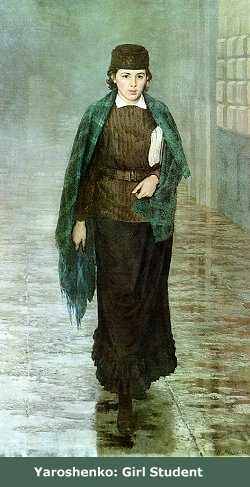 eeble-minded – слабоумный
eeble-minded – слабоумный devotee – фанатик, человек преданный к-л делу
the pilgrim – паломник, странник
absorbed in deep thought - глубоко погруженный в мысли
beggar - бедняк
to kneel – преклонять колени
dispersing crowd – расступающаяся толпа
drawn face - искаженное лицо
2.14. Nikolay Yaroshenko
(1846 – 1898)
Nikolay Yaroshenko, who was called “the conscience of the Itinerants”, for his integrity and adherence to principles, created his own portrait type, and his representation of a specific model became the basis for his generalized image of the representation of the different layers of society. “Girl Student”, is typical of Yaroshenko. His “Portrait of Pelageya Strepetova”, a Russian tragical actress, is a very good example of his work. She specialized in the roles of the poor and humiliated, exhausted by life women, and these roles left their mark on this portrait. Looking at the clenched hands of this fine, young, but not pretty woman, we can feel her inner strength and the emotional strain in her image. This image probably reminded contemporaries of young girls exiled to the mines for expressing their ideas. One critic noted the resemblance of bracelets on her wrists to fetters.
Notes
the conscience - совесть
integrity - прямота, честность, целостность
adherence to principles - приверженность (верность) принципам
humiliated - униженный
to clench hands – сжимать кулаки
emotional strain – эмоциональное напряжение
the resemblance – сходство
fetters - кандалы, оковы
2.15. Viktor Mikhailovich Vasn
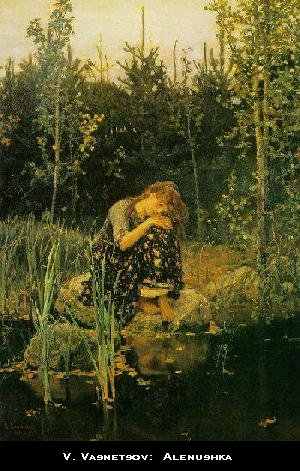 etsov (1848-1926)
etsov (1848-1926)Viktor Mikhailovich Vasnetsov was a painter whose works revealed an important facet of Russia's art during the period of Russian Revival. The son of a country priest, he attended a seminary before beginning his artistic education at the Petersburg Academy and later, at the Academy of Arts.
Vasnetsov created many genre scenes, his style changed as the tide of public support turned against such prosaic, "social" art. By 1880 he was busy painting historical and legendary scenes taken from Russia's colorful past. Although by now there are some who doubt the enduring quality of his work, during Vasnetsov's lifetime he enjoyed at least a moderate level of popularity and appreciation and fulfilled various commissions for both museums and churches.
Vasnetsov was probably the first painter to create theater backdrops; he began working in this capacity during the 1880s and 1890s. These efforts were also an expression of the Russian Revival, for out of his work and that of his followers sprang the idea of "realistic theatrical décor," which contributed much to the development of the Russian theater and ultimately was quite influential in Western Europe
2.16. Isaak Iljich Levitan (1860 – 1900)
Левитан Исаак Ильич - русский живописец-пейзажист, сын мелкого железнодорожного служащего. Учился в Московском училище живописи, ваяния и зодчества у А.Саврасова и В.Поленова. С 1891 член Товарищества передвижникоов. Восприняв у Саврасова метод тщательного изучения натуры и поэтизации обыденного, приближаясь к пленэрной живописи на основе опытов Поленова и мастеров Барбизонской школы, Левитан в начале 1880-х гг. переходит к более широкой манере, к раскрытию тончайших состояний природы и атмосферы, к цельности эмоционального образа (“Осенний день”, “Сокольники”). Одна из главных тем Левитана – величие волжских пространств (“Вечер на Волге”, 1888).
В его творчестве рождается так называемый пейзаж настроения, в котором состояние природы осмысливается как выражение движений человеческой души. Природа предстает у Левитана поэтически преображенной, духотворенной незримым присутствием человека. В дальнейшем передача конкретных ландшафтов постепенно сменяется воплощением самого характера русской природы, типичных ее черт. Овеянные традиционными народными представлениями, эти произведения во многом отражают понятные современникам мысли, чувства и настроения.
В картине «Владимирка»(1892) впервые возникает, ставшая затем одной из центральных, тема дороги и ее влекущая вдаль сила. Изобразив тракт, по которому шли сосланные в сибирь на каторгу, художник также заявил о своей общественной позиции. Цветонасыщенность, прозрачность чистых цветов, внутренняя динамика живописи ряда работ в известной мере созвучны стилистике импрессионизма.
(“Березовая роща”,1885-89гг., “Март”). В больших композициях эти качества служат средством достижения мажорной звонкости цвета, сочетающейся с устойчивой определенностью форм (“Золотая осень”, 1895).
Творчество Левитана связано с общими стилистическими исканиями русского искусства этого времени, отмечено также тяготением к большей обобщенности письма, к плоскостно-декоративному остросилуэтному разрешению композиции, к некоторой драматизации пейзажного мотива (“Над вечным покоем”, 1894; “Сумерки. Стога”, 1899). Искусство Левитана составило эпоху в развитии русской пейзажной живописи, оказав значительное влияние на следующее поколение художников-пейзажистов. (БСЭ, т. 14, с.238-239)
Task 13. Learn this description. Isaak Levitan: The Vladimirka road (1892)
Levitan often combined his realistic vision with a strong message. In this case, the desolation of the landscape echoes the message conveyed by the road itself. The Vladimirka road is the road taken by the exiles to reach S
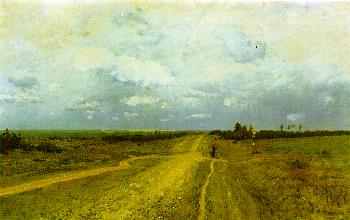 iberia. Levitan was probably making reference to his own exile, which occurred in the same period. Like many political prisoners, he had been evicted from Moscow because he was Jewish, and this experience would leave a profound mark on the painter's soul. The sky and the fields are all part of the symbolic message that Levitan wants to render through his painting. Colors are dull and rather unattractive. Levitan chooses browns and dull greens so that nothing would stand out; the sky is blue-gray, cloudy, and unforgiving. There is no sun peeking from behind the clouds, as if the painter wanted to say that there is little hope for those who would take that road. The landscape is flat and, with the exception of the trees in the background, has no other vegetation except some sparse yellowish grass. The road appears to have no end. Perhaps Levitan is trying to say that the prisoners are forever itinerants or that Russia is so vast that human beings "vanish" in its unlimited space. There are no human figures, which seems to be a characteristic feature of realistic landscapes of other painters (Shishkin, for instance) and of Levitan himself. Actually, the tendency to “de-humanize” compositions by excluding human figures would be a recurrent feature in Levitan's work.
iberia. Levitan was probably making reference to his own exile, which occurred in the same period. Like many political prisoners, he had been evicted from Moscow because he was Jewish, and this experience would leave a profound mark on the painter's soul. The sky and the fields are all part of the symbolic message that Levitan wants to render through his painting. Colors are dull and rather unattractive. Levitan chooses browns and dull greens so that nothing would stand out; the sky is blue-gray, cloudy, and unforgiving. There is no sun peeking from behind the clouds, as if the painter wanted to say that there is little hope for those who would take that road. The landscape is flat and, with the exception of the trees in the background, has no other vegetation except some sparse yellowish grass. The road appears to have no end. Perhaps Levitan is trying to say that the prisoners are forever itinerants or that Russia is so vast that human beings "vanish" in its unlimited space. There are no human figures, which seems to be a characteristic feature of realistic landscapes of other painters (Shishkin, for instance) and of Levitan himself. Actually, the tendency to “de-humanize” compositions by excluding human figures would be a recurrent feature in Levitan's work. Task 14. Enrich this description with your own impression.
In “Above Eternal Peace” Levitan has created an image so beautiful and so memorable that it would be difficult to dismiss it lightly as just another landscape painting. As much as painting an image of the Russian land, Levitan evokes a mood of peace and tranquility that becomes inseparable from the idea of space and freedom, and from the universal quality of beauty and art. Benois said that Levitan "felt that Nature lives and praises the Creator," and no painting expresses this sentiment quite like “Above Eternal Peace”.
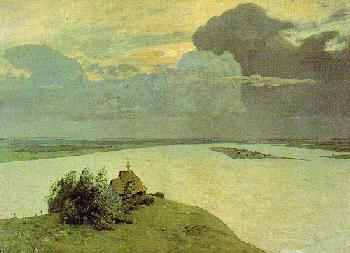
I. Levitan. “Above Eternal Peace”.
Oil on canvas, 150 x 206 cm. Tretiakov Gallery, Moscow
The composition of this painting is both aesthetically affective (with its irregularly shaped divisions of the picture plane and clear center of focus) and symbolically effective. While the graveyard (to the left of the church) may symbolize death, the church itself (as the focal point of the painting) seems to whisper that there is another way – a way to live – and this way is through Jesus and the divine plan God implemented through his birth, death, and resurrection. The still plane of water behind the church emphasizes this idea and the peace granted to those who accept it. This entire image asserts the strength of not so much the Russian Orthodox Church, but the beliefs it represents. In this way, and in the pride of countryside so beautiful and so lyrical, does this painting express the beliefs and aims of the Russian Revival of the late 19th century, and serve as a fine example of the "deeply poetic vision" Levitan achieved in his art.
2.17. Valentin Alexandrovich Serov (1865-1911)
One of the greatest Russian portrait painters, Serov was born on January 19, 1865, in the family of the composer A.N.Serov, author of the operas Judith, Rogneda, and the Evil Power. As a young boy, Serov might have met many luminaries of Russian culture of the time - Stasov, Repin, Ghe, Antokolsky - who visited his father. Unfortunately, when he was six, his father died, and Serov traveled with his widowed mother to Munich and later to Paris. In Paris, he attracted Repin's attention and started his art education under the master's tutelage. Impressed by the talent of the boy, Repin advised him to return to St.Petersburg and begin formal studies at the Academy of Fine Arts under the famous art teacher P.Chistiakov. Savva Mamontov invited financially destitute Serovs to live at his estate at Abramtsevo. Serov studied at the Academy from 1880 to 1885 and met Mikhail Vrubel there; the painters even shared an atelier. Even though the artist did not finish the Academy, he sufficiently perfected his skills to begin independent work.
He became famous after exhibiting “ Girl with Peaches” (1887) and” Girl Lit by the Sun” (or “Girl in the Sunlight”), both considered to be among the greatest masterpieces of the Tretiyakov Gallery. The first canvas, a portrait of Savva Mamontov's daughter, Vera, brings to mind sunny and cheerful portraits by Renoir, but is probably more inspired by the colors of Repin's paintings, particularly “They Did not Expect Him”. In its colors and juxtaposition of light and shadow, the second canvas is also strongly influenced by Repin's works.
Initially a strong follower of the Wanderers and a supporter of the idea of utilitarian purpose of art, in 1890s Serov, following the example of his mentor, Repin, diasgreed with the Wanderers' “dictatorship” and imposition of standards on the young artists and left the Society; instead, he became close to the World of Art group, which allowed him to exhibit his paintings without interruptions even though he never subscribed to all points of the group's program. Popularity which Serov gained after showing his first two acclaimed portraits made him an artist in great demand. He painted almost 700 canvasses; including portraits of famous art maecenases, artists, actors and actresses, writers and poets, composers and singers, and politicians. Not surprisingly, the names of his sitters read as a who-is-who in Russian culture and politics of the late nineteenth and early twentieth century: Savva Mamontov (1890), Konstantin Korovin (1891), Ilya Repin (1892), Isaak Levitan (1893), Nikolai Rimskii-Korsakov (1898), Emperor Nicholas II (1900), Konstantin Pobedonostsev (1902), Anton Chekhov (1903), Sergei Witte (1904), Fiodor Shaliapin (1905), Konstantin Balmont (1905), Maksim Gorkii (1905), M.I.Ermolova (1905), E.L.Nobel (1909), Ivan Morozov (1910) and many others.
